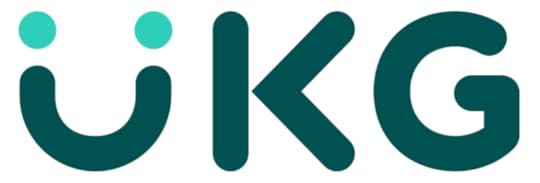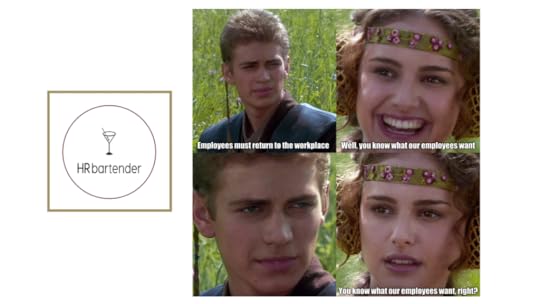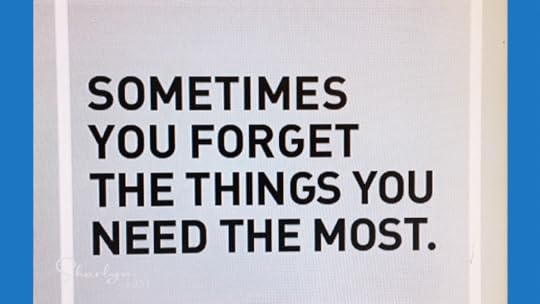Sharlyn J. Lauby's Blog, page 55
April 12, 2022
UKG HR and Payroll eSymposium: Become Your Best Self at Work

Estimated reading time: 5 minutes
(Editor’s Note: Today’s article is brought to you by our friends at UKG – Ultimate Kronos Group . Join UKG in making pay equity a priority. UKG recently launched a Pay Equity Resource Center , designed to provide information, learning opportunities, and other valuable research to help close the wage gap. Check it out when you have a moment and enjoy the article!)
I’m always on the lookout for FREE professional development events that deliver on quality. Today, I want to remind you that the UKG HR & Payroll eSymposium is coming up on Wednesday, May 4, 2022, from 10a to 4p Eastern. I’ve been participating in these eSymposiums for a few years and find them to consistently be a high-quality learning opportunity.
The theme of this event is “Rise Up: Become Your Best Self at Work”, which is a very timely subject because as HR and payroll professionals, we’re often so busy taking care of everyone else that we forget to take care of ourselves. Before I give you a sneak peek into the program, I want to share four benefits that I’ve found attending this event.
It’s FREE. Sometimes free things are good and sometimes … well, they’re not. This is one of those good, free events. As much as we might want to travel to an event right now, the cost of travel is pricey. So, when we can find a good, free event, we need to take advantage of those moments. The sessions will be recorded. If you’re not able to attend the live sessions, no worries. Most sessions will be made available on demand. That way if you’re torn between two sessions then you can listen to one live and the other on demand. Honestly, there are times when I prefer listening to the recordings. I can schedule my learning over time. That way, if I do have to step away for an emergency, I know that I can still listen to the recording and not miss out on the information. The content is relevant and high-quality. One of the things that I really like about this event is that it brings together HR and payroll. I’ve been responsible for both a few times in my career, and this is one of the few events that has topics which are relevant to both. Since the event is free, your organization can have multiple people attend, and then maybe set up a meeting to discuss the sessions. It’s a great way for HR and payroll to learn from each other.You can earn recertification credits. Recertification credits are important, especially if budgets are tight. The eSymposium sessions have been pre-approved by the Society for Human Resource Management (SHRM)and the Human Resources Certification Institute (HRCI). In addition, many have been approved by the American Payroll Association (APA). And for my Canadian friends, this event is also pre-approved by the Human Resources Professionals Association (HRPA), Chartered Professionals in Human Resources Saskatchewan (CPHR-SK) and the National Payroll Institute (NPI). UKG will be providing a certificate of participation for your files. Rise Up: Become Your Best Self at WorkNow, as promised, here’s a sneak peek at the agenda. It’s divided into four tracks: stay sharp on compliance, practice ethical leadership, prioritize safety and wellbeing, and own your vision. Here are a few of the sessions being offered:
The Goal Setting Blueprint for Successful Professionals – Goal setting is more than simply writing down our wishes. In this session, led by Dr. Chris Mullen, executive director of The Workforce Institute, you’ll blend academic and action to learn the best process for creating achievable goals that drive you forward professionally.
Remote Employees: A Compliance Watchlist – The compliance advisory team at UKG will be leading a discussion on the compliance considerations of remote work, including tracking local taxation and sick leave laws, wage and hour issues, and related trends such as “the right to disconnect”.
The New Ethics of Leadership – Dr. Jarik Conrad, executive director of UKG’s Equity at Work Council, will be talking about the characteristics of ethics in leadership and how these characteristics are being viewed by employees, customers, and investors. While it might seem like nothing is new in this area, expectations have changed significantly.
The Power of Embracing Self-Care through Micro-Habits & Holistic Wellbeing – As HR and payroll pros, one of our primary responsibilities is being there for others. The way we do that – and do it well – is by taking care of ourselves. Learn practical strategies that can be woven into your hectic lives for improving overall physical, mental, financial health, and lifestyle.

Again, this is just a handful of the eSymposium sessions being offered. You can check out the entire agenda, speaker profiles, and save your spot by visiting their website.
Developing Our Knowledge and Skills Leads to Our Best SelfHR and payroll professionals are focused on a lot of things right now. Not only all our usual responsibilities, but we are working with the management team on fill all those job openings as well as welcoming employees back to the office. There are days when we say to ourselves we can’t possibly think about taking time off to attend a professional development program. But we just have to find the best way.
Now is the time to take some of our own advice. If a manager or employee came to us about not having time for learning, we’d tell them that “developing our knowledge and skills makes us better at our jobs”. And it’s true.
The UKG one-day eSymposium for HR and payroll professionals is designed to deliver education on the topics we face every day and could potentially face in the future. It has, what I think, are the ingredients many of us look for in professional development opportunities: 1) high-quality content, 2) no cost to attend, and 3) pre-approved for recertification. We all know this doesn’t happen very often. Find some time to focus on your professional development. It’s important. Sign up for the UKG eSymposium. Here are the registration details:
Rise Up: Become Your Best Self at Work
Wednesday, May 4, 2022, 10a to 4p Eastern
Look forward to seeing you there!
The post UKG HR and Payroll eSymposium: Become Your Best Self at Work appeared first on hr bartender.





April 10, 2022
Make the Workplace Worth the Commute

Estimated reading time: 3 minutes
I discovered an informative website recently called the Microsoft Work Trend Index. It’s focused on providing insights about hybrid work as well as work in general.
I know that some organizations are focused on inviting employees back to onsite work and trying to reduce the amount of remote and hybrid work available to employees. Every organization must make this decision for themselves. They know their employees and what their employees want. Everyone wants to work onsite? Great, give employees what they want. Employees want hybrid and company wants onsite? Well, decisions have to be made.
One of my takeaways from the Microsoft site was that organizations need to make the workplace worth the commute. By now, we’ve probably all seen at least one news headline about employees coming to the office to be on Zoom calls. And we know what employees are thinking – “I can do this at home. Why did I have to put on a suit, spend 30+ minutes in traffic with gas prices $4+/gallon to sit on Zoom calls?!” So, there’s something to be said about making the workplace worth the trip.
Let employees prioritize their work schedule. I believe this is where hybrid work and making the employee experience worthwhile meet. If an employee is working on a project that requires quiet and concentration, let them work on it where it makes sense for them. If they need to be in face-to-face meetings with clients, then they know where they need to be. Let employees create a work schedule that allows them to get the work done in the most effective and efficient means possible.
Give employees good technology. Over the past couple of years, we’ve learned the value of good technology. Make sure employees have it. Good technology can improve communications, streamline processes, and offer flexibility. Giving employees access to good technology is more than simply handing them a piece of equipment or a link to download some software. Organizations need to provide training on how to optimize their tech usage and how to keep data safe and secure.
Design a functional workspace. I believe it’s safe to say that the concept of work is changing has changed. Some employees might tell you that foosball tables and nap pods are workplace essentials. But my guess is that employees want to come to a workplace that’s clean and ergonomically friendly. They want natural light. They want the ability to tune out their noisy coworkers and ambient noise. They might want snacks, since the inflation is impacting the cost of their lunch. Organizations need to get workspace basics right.
Tell employees why they’re there. Most importantly, employees want to know why they’re onsite. And the reason must be valid and believable. Don’t tell employees that they need to come onsite to do something that they’ve been doing remotely for 2+ years. Don’t tell employees that they need to work onsite for the “team” when the team didn’t really talk to them before. I think this is going to be really tough for organizations to explain. Give employees a heartfelt reason to be there.
Making the workplace worth the commute isn’t just a “let’s get employees onsite” move. It should be viewed as an employee engagement strategy. One of the attributes of employee engagement is that employees want to get up and come into work every day. Well, if organizations make the workplace worth the trip, they’re creating an environment where employees feel connected to the company. That’s good for everyone.
The post Make the Workplace Worth the Commute appeared first on hr bartender.





April 7, 2022
Holding Back Authenticity? Employees Should Understand Why

Estimated reading time: 4 minutes
A few weeks ago, I asked you about authenticity. Specifically, whether you’re able to bring your authentic self to work. Here’s what you said:

I want to thank everyone who responded to this poll. It wasn’t an easy question. In fact, shortly after the poll launched, someone sent me a note saying, “Being authentic comes with a price.” It’s true. However, not being authentic also comes with a price. My question is, do employees know why they’re not being their authentic self at work? If so, then great! But if not, this could be an important self-awareness moment.
It could be imperative for organizations to understand authenticity as well. If companies are trying to create more inclusive work environments, understanding why employees might be holding back could be significant. Here are a few reasons that employees might hold back their authentic selves.
They want to fit in. Peer pressure is huge, even in corporate settings. Even if people hate them, the coffee gatherings and happy hours are opportunities to build relationships that might help someone in their career. Unfortunately, some groups don’t make it easy to accept “I’m tired and just want to decompress all by myself.” as a legit response to an invite. Employees need to feel a sense of balance between being themselves and being a part of the team.
They’re afraid of judgement or disapproval. Even if the organization doesn’t have get-togethers, there are times when fitting in includes being able to talk about the same things as everyone else. For example, an employee might fake their way through the conversations about March Madness games because the team will be talking about them – even though the employee didn’t watch them. And the employee might refrain from sharing that they snagged a shiny Mankey in Pokemon Go over the weekend because the team thinks it’s a kid’s game.
They don’t trust someone. Employees might not feel ready to open up to someone they don’t trust. This is where the conversation can impact building positive working relationships. For example, a coworker shares mean gossip or gives out false information. The employee then decides to keep their distance and only shares information on a “need-to-know basis”. This can also happen if a coworker offers some friendly advice like, “I wouldn’t trust that person if you know what I mean.” The employee might choose to hold back until they know differently.
They don’t want to have their feelings hurt. Mistakes happen all the time. Misunderstandings happen. Most of the time, employees talk those situations through, and they’re able to repair the relationship. But there are also times when the mistake or misunderstanding changes a relationship permanently. An employee might have a personal experience that makes them question how much sharing they want in the future. Or they might witness a very public fallout that changes their mind about sharing.
Organizations have to also think about whether they allow more authenticity from their high potential and high performers, versus everyone else. Does the top salesperson in the company get to be their authentic self more because of their contribution? Is that okay? And if they stop being the top salesperson, will the situation change?
Fast Company recently published an article on “3 reasons not to bring your authentic self to work”. It’s a good read, but it takes me back to the takeaway of the poll. Individuals need to understand why they are holding back authenticity and ask themselves, “How much am I holding back?” and “Am I comfortable with it?” And organizations should also be asking questions if their employees feel the need to hold back. Is that the type of workplace that supports the company culture? Would authentic employees make the workplace better?
Image captured by Sharlyn Lauby while exploring the streets of Anaheim, CA
The post Holding Back Authenticity? Employees Should Understand Why appeared first on hr bartender.





April 5, 2022
Employees Should Develop More Emotional Intelligence

Estimated reading time: 5 minutes
(Editor’s Note: Today’s article is brought to you by our friends at Criteria , a leading provider of pre-employment testing services. I hope you’ll take a moment to check out their new case study using cognitive aptitude and emotional intelligence testing to improve the candidate experience and job offer acceptance rates . Very interesting and timely! Enjoy the read.)
A few months ago, we published an article about how candidates and employees find “Low Empathy Workplaces are not Attractive”. The reason they aren’t attractive is because empathy is a key component of diversity, equity, and inclusion (DEI). Candidates and employees want to work someplace where they feel they can be their authentic self, which means they want to work at workplaces with high empathy.
But developing and demonstrating empathy can be hard. Empathy is the ability to recognize, understand, and share how others are feeling. It’s a key element in the concept of emotional intelligence.
Emotional Intelligence is Focused on EmotionsThe title of this subheading isn’t meant to be flip. Sometimes, I believe when we’re thinking about emotional intelligence, we put the emphasis on the wrong word. Where empathy is the ability to recognize how others are feeling, emotional intelligence (EI) is defined as the ability to manage one’s own and others’ emotions.
Many people have studied EI but it was popularized by Daniel Goleman in the book “Emotional Intelligence”. Modern EI theory suggests that it has three domains: emotion perception, emotion understanding, and emotion regulation. The domains follow a progressive sequence, like a cascading effect. So, they are very interrelated.
Emotion perception is when we are conscious or self-aware of our own traits, behaviors, and feelings as well as those of others. It includes being able to sense what others might be feeling, even when we don’t agree with those feelings. It might also include being able to identify genuine versus inauthentic emotions and behaviors.
Emotion understanding happens when we can recognize complex (and possibly conflicting) emotions. It also involves recognizing and understanding that emotions can evolve over time. An example might be a person experiencing the stages of grief or a change process where at one point the person is sad and then they’re angry.
Emotion regulation could be thought of as a form of self-management. It means that we’re able to integrate emotion perception and emotion understanding into our interactions with others to achieve positive outcomes. Emotion regulation could involve resisting our biases to recognize the views of others.
By just reading these descriptions, you can see how EI has a connection to our personal and professional lives. Empathy is connected to the EI domains of emotion perception and understanding. But we need to know how to apply emotion perception and emotion understanding in our interactions. That’s where emotion regulation comes in. So, this isn’t like “just pick one” to work on. As I mentioned earlier, they’re interrelated.
Developing Emotional IntelligenceThis section takes me back to the beginning of this article. Since candidates and employees want to work someplace where they can be themselves and have good working relationships, it’s important to develop emotional intelligence.
Some of you might be saying, “This is great, and I totally agree with everything you’ve said. How do we help employees develop their EI skills?” Well, here are four activities to consider. Please note: EI development isn’t a one and done activity. Like all skills development, this will require continuous effort.
ASSESSMENTS can offer individuals and organizations guidance on a person’s strengths and opportunities around emotional intelligence. This can be a great way to objectively begin development activities.SKILLS TRAINING in subjects like empathetic listening, communication, and change management can help employees find tools that will facilitate better interactions.PRACTICE activities in a safe environment would give employees opportunities to put their learning into real-life situations. Psychological safety will be essential for employees to feel comfortable sharing their thoughts.FEEDBACK sessions with managers, mentors, and even tools like 360 (multi rater) assessments can provide individuals with feedback regarding their efforts.Good Working Relationships = Better OrganizationsI know that so far in today’s article we’ve been very focused on the benefit to employees in developing emotional intelligence. That benefit extends to organizations as well. Companies want employees to have good working relationships. With their manager. And their coworkers. Good working relationships mean better employee performance. Better employee performance creates a healthy bottom-line.

In a new ebook from our friends at Criteria titled “Emotional Intelligence at Work”, they share the results from a study that shows a clear relationship between emotional intelligence and job performance. A couple of statistics that jumped out at me:
19% higher rating in EI translated to employees doing more than what is expected18% higher rating in EI meant employees were better at maintaining their composure when under pressure26% lower rating in EI signaled an employee’s unwillingness to learn new skillsThese are all qualities that employers are looking for: employees who can go the extra mile, stay calm in frustrating encounters with customers and/or coworkers, and will learn new things to be better at their job. It only makes sense for companies to support efforts for employees to learn more and develop their emotional intelligence. It makes for better working relationships and organizational results.
If you want to learn more about how emotional intelligence can benefit your employees and the organization, don’t forget to download the ebook mentioned above and join us for a webinar “Emotional Intelligence Matters: The Value of EI at Work” on Wednesday, April 27, 2022 at 10a Pacific / 1p Eastern.
Workplace dynamics are changing all the time which means we need to keep our relationship building skills current. Continuously working on the EI domains is an investment into our work relationships, which is at the heart of organizational connection and communication.
The post Employees Should Develop More Emotional Intelligence appeared first on hr bartender.





April 3, 2022
Replacement Planning Is an Important Part of the Succession Planning Process

Estimated reading time: 5 minutes
I recently saw an article on the Gartner blog titled, “Implement Succession Planning, Not Replacement Planning.” It’s a good read about improving succession planning processes, so check it out when you have a moment. But succession planning and replacement planning are not the same thing. So, while I agree with the author that organizations should have succession plans, don’t dismiss the value of a replacement plan.
A replacement plan identifies “backups” for positions. Traditionally, it has focused on top-level roles, but it can be done for any position in the organization. Replacement planning is often mentioned in conjunction with succession planning because it identifies individuals who can assume roles at some point in the future and shows how ready they are for that position. But replacement planning doesn’t have to be defined as a subset of succession planning.
Having individuals – whether they are regular full-time, part-time, or contractor – identified as backups just makes good business sense for a variety of reasons. We’re regularly hearing stories about “The Great Resignation” and employee turnover. And as much as we don’t like to mention it, employees can become unexpectedly seriously ill or have an accident and be unable to work. The organization needs to find someone to take over their responsibilities—even if it’s only temporarily.
Since organizations don’t always get to control the timing and circumstances, having a staffing backup plan (aka replacement plan) makes sense. Recruiters will want to have a say in how that plan is developed.
If your organization has a formal succession plan, there might be replacements identified. Or it could be an added step in the existing process. Even if you’re using talent pools instead of a succession plan for employee development, replacement planning can add value. Here are four steps to consider as part of a replacement planning activity:
Step 1. Identify key positions and the critical skills for each position. While every job is important, certain roles within the organization would significantly impact the business if left open for a long period. Using your average time to fill as your benchmark, identify which positions must be filled in less time. Ideally, we’d like every job to be filled quickly, but identify those that must be a priority. Those key positions are a place to start. And you should have much of this information from your workforce plan and staffing analysis.
Then for each position,list the qualities that anyone holding this position must have. This isn’t a wish list. Remember this is a replacement plan. If someone had the basic skills, then they could learn the other knowledge, skills, and abilities required for the position.
Step 2. Assess the skills of current employees and match their skills to the list of critical skills. Again, your workforce plan and/or staffing analysis should contain some of this information. If not, you can obtain it in the form of training records, performance reviews, coaching feedback, and 9-box grids. It might also be helpful to look at the skills of freelancers and consultants who currently partner with the organization or former employees who might be interested in returning.
This step is when organizations might be tempted to think that backup employees are currently in the department—for instance, the accounting manager is the obvious backup for the accounting director. However, a recent transfer might be interested in returning to their former department. Keep the planning activity focused on skills, not current job titles.
Step 3. Pay attention to jobs that don’t have matches and develop a plan to address the gaps. It’s possible that this exercise might surface some jobs that need immediate attention—meaning there is no immediate replacement available. While that’s not a place anyone wants to be, it’s better to learn this information during a planning activity than when you’re trying to fill an opening. And this is one of the reasons that talent acquisition professionals need to be a part of the conversation so there are no surprises.
Create a plan to address gaps including development programs, mentoring, coaching, special projects, and contingent staffing. Or a combination of all these programs. With replacement planning, the organization doesn’t have to identify a single replacement. Use talent pools to develop transferable skills for many positions.
Step 4. Evaluate the plan. On a regular basis evaluate the plan to make sure the company’s needs can still be met. For key positions, the individuals currently holding those roles can be tasked with helping to identify their replacement and train them. This goal could be rolled up into their performance review.
One other aspect to consider when evaluating the plan is how replacement positions will be filled. Another reason to have talent acquisition in the room. For example, if a sales manager leaves today, the company has identified someone to replace them. But what about the new opening that’s been created? Obviously, there’s a chain reaction that takes place and the organization needs to have a recruiting plan to address it.
Replacement plans do one other thing. They give the organization a sense of the investment they will need to make should a backup be necessary. Whether it’s temporary or long term, employees asked to assume greater responsibilities need support. Regular replacement planning activities make the organization keenly aware of the support the affected employees will need to be successful.
While organizations are working hard to hire, engage, and retain the best talent, it would be naïve to think employees never leave. Replacement plans provide the organization with the comfort that a last-minute resignation, retirement, or employee illness will not leave the company at a talent disadvantage.
Image captured by Sharlyn Lauby while exploring the streets of Los Angeles, CA
The post Replacement Planning Is an Important Part of the Succession Planning Process appeared first on hr bartender.





March 31, 2022
4 Qualities of High Performance in Employees

Estimated reading time: 3 minutes
I came across an article recently titled “My lesson from successful scientists: success can be learnt” and it piqued my interest. I believe in science, and I believe in trying to achieve success. While I’m not sure the article completely delivers on its title, it did a great job of defining high performance, at least that was my takeaway.
Define what success means to you. This is the one moment in the article where I thought the article places a focus on “success” versus “performance”. I agree with the author that everyone’s version of success can be different. And for that reason, the path we choose to create our success might be different. It’s also possible that our definition of success might change over time. And if you live with others, there could be times when the group will have to reach consensus on a definition for success.
Given what we’ve been experiencing over the past couple of years (and are still experiencing today), if you haven’t thought about what success means to you, it might be time to revisit it. Make sure the definition aligns with your values. It’s okay to change it and still focus on high performance.
Work smarter not longer. To achieve success, we must perform. And we must perform at a high level. That doesn’t mean we have to work lots of hours. It doesn’t mean we have to give up our personal lives. But we do need to know how to work effectively and efficiently. We need to understand what our most productive self looks like, and we need to be able to communicate to the people around us what we need to become that productive.
Ask yourself, “What helps me become my most productive self?” and “Do I have all those things around me?” Take it one step further and ask, “What keeps me from being my most productive self” and “How do I minimize or eliminate those things?”
Celebrate your successes then get back to work. We all want recognition for our efforts. Sometimes, we get that recognition from others. Sometimes, we acknowledge that recognition by ourselves. Either way, don’t forget to celebrate in some way – big or small or quiet or loud. Just celebrate. Then keep going. Whether that’s on the next goal or the everyday stuff, continuing to move forward somehow makes the celebration even sweeter.
Think about how you would like to celebrate your achievements. If you’re hoping to receive recognition from others, do they know the best way to express their thanks? If not, maybe it’s time to tell them. And as an individual, is your self-talk supporting your accomplishments?
Learn, learn, and learn some more. The world is changing, and we must change with it for high performance. This doesn’t mean that we have to be early adopters of everything. But we can read about new trends. We can listen to people who challenge the status quo – and then decide if they make sense or are full of gibberish. The good news is that learning can happen so many ways and we can take advantage of all of them.
Figure out how you like to learn. Find low cost and no cost ways to learn. I think books, blogs, podcasts, and massive open online courses (MOOCs) are a great start.
Honestly, I don’t know that it’s a guarantee that success can be learned. I do know that we can develop the qualities of high performance. Then it becomes how we apply those qualities. We need to regularly check-in with ourselves to ensure that we’re on the right path and performing optimally.
Image capture by Sharlyn Lauby while exploring the Wynwood District of Miami, FL
The post 4 Qualities of High Performance in Employees appeared first on hr bartender.





March 29, 2022
Labor Law Posting Requirements for Hybrid and Remote Work #MindTheGap

Estimated reading time: 7 minutes
(Editor’s Note: Today’s post is brought to you by our friends at Poster Guard®, a division of HRdirect and the leading labor law poster service that gets your business up to date with all required federal, state and local labor law postings, and then keeps it that way — for an entire year. Enjoy the article!)
I saw an article recently on CNN talking about the companies that have decided to go fully remote – permanently. It was a good reminder that while many organizations are planning “welcome back to the workplace” events, several are opting to keep remote work as a part of their operation.
It completely makes sense. There are many benefits to remote work. For organizations, there’s a cost savings in rent, utilities, cleaning, equipment, etc. It can also create benefits in attracting talent. For employees, remote work can save money in terms of working attire, commute expenses, and childcare expenses. It can also positively contribute to overall wellbeing. And technology tools are allowing remote workers to still communicate, collaborate, and get work done.
But all this talk about remote work does raise the question, how do organizations communicate with employees when it comes to topics like workplace compliance postings. I know organizations need to be focused on getting the work done, but we also need to make sure all employees know their rights as required by federal, state, and local law.
I had the opportunity to speak with our friend Ashley Kaplan, senior employment law attorney for HRdirect about this issue. Ashley leads the expert legal team for Poster Guard Compliance Protection. Please remember that even though today’s post is sponsored, Ashley’s comments shouldn’t be construed as legal advice or as pertaining to any specific factual situations. If you have detailed questions, they should be addressed with your friendly neighborhood labor and employment attorney.
Ashley, before we talk about the posting requirements for remote employees. It might be good to discuss, in general, the current posting requirements for organizations.
[Kaplan] Sure. All employers must post federal, state, and local (if applicable) postings. The mandatory federal notices that most employers are required to post include:
Equal Employment Opportunity (EEOC) Employee Polygraph Protection Act (EPPA)Fair Labor Standards Act (FLSA)Family and Medical Leave Act (FMLA)Occupational Safety and Health Act (OSHA)Uniformed Services Employment and Reemployment Rights Act (USERRA)In addition, there could be up to 19 additional state-specific posters, depending upon what state you’re in … and up to 11 additional posters for city/county compliance. Oh, and don’t forget there are additional posters for government contractors and certain industries. The topics for these state, local, and industry-specific postings include minimum wage, fair employment, safety, child labor, unemployment insurance, workers’ compensation, family/medical leave rights, smoking in the workplace, human trafficking, and more.
For HR pros who just read that list and are saying to themselves, “I have no idea if we have the right posters!” is there a government site that will tell them everything they need?

[Kaplan] Unfortunately, there’s not a ‘one-stop shop’” where employers can get all of the government-issued notices for federal, state, and local compliance. The postings are issued by multiple different government agencies. Very few of the agencies work together, so the only way to ensure compliance is to check each issuing agency’s requirements directly. For federal and state posters, there are about 175 different agencies responsible for issuing more than 400 posters nationwide. Add to that the approximately 22,000 local jurisdictions that have the authority to issue their own postings. That’s a lot of follow-up and unfortunately, these agencies aren’t required to coordinate efforts.
Okay, so potentially HR pros have several many a lot of sites to check. But do posters really change that often?
[Kaplan] Surprisingly, they do. Our Poster Guard legal team monitors posting changes and has reported a significant increase over the past few years. In 2021, the team tracked more than 200 mandatory poster updates impacting U.S. employers, and this number is expected to increase in 2022 as state and local employment laws continue to evolve at a record pace. Most employers are aware of poster updates relating to minimum wage increases, but other poster changes are just as critical. It can be a challenge to stay on top of all these updates because the government agencies don’t notify employers when requirements change. Also, be aware that mandatory posting changes are issued throughout the year, not just in January.
Honestly, I don’t remember labor law posters being so complex. How do current labor law posting requirements impact remote workers?
[Kaplan] By law, you’re required to provide these mandatory notices to ALL employees. That includes employees who work from home, offsite, on the road, at mall kiosks, in mobile service units, out in the field, at construction checkpoints, and other remote worksites.
Does this mean that HR needs to send remote workers full-size laminated posters to hang in their spare bedrooms/home office?
[Kaplan] No, but it does mean that employees need to receive notices. Although the regulations don’t specify the format — paper or electronic — organizations are responsible for communicating the same information to their remote workers as those onsite. For employees who work on computers as part of their jobs, the most effective way to distribute the posters is through electronic delivery. We recommend using a solution that enables your employees to download, view, and acknowledge receipt of all required postings and posting updates. This satisfies your obligation to communicate their rights, and the acknowledgments provide additional support in the event of a dispute.
That raises another question about what information should an employee receive. If a company has remote employees who work in different states, which posting requirements should they follow? Those from the state where the company is headquartered or the state where the employee works?
[Kaplan] Unfortunately, it’s not always clear which state laws apply in this instance. Most basic employment rights — such as minimum wage, overtime, and safety issues — are governed by the laws where the employee performs the work. However, depending on how your company is structured and the nature of work performed, your out-of-state employees may be covered by both states’ laws. Because it depends on so many factors, we recommend you provide remote workers with access to both sets of state-specific postings in this situation.

What if an organization is offering hybrid work where employees primarily work from home, but they report to the office headquarters occasionally? Do they still need to send posters electronically?
[Kaplan] FAQs published by the U.S. Department of Labor (USDOL) suggest that, if an employee reports to a company’s physical location at least 3-4 times a month, the physical postings at the business are adequate. If not, the USDOL recommends electronic delivery.
Last question. I could hear some people saying, “Labor law posters aren’t a big deal. If we don’t have them, we’ll just get a warning.” What’s the penalty for businesses who are not in compliance?
[Kaplan] Recently, the amount for federal posting fines increased to more than $38,000 per violation, per location. State and local fines typically range from $100 to $1000 each. Government fines can add up, but the real danger is with employment litigation. A missing or outdated posting can impact damages and can even ‘toll’ or extend the statute of limitations. And as your readers know, the statute of limitations can often be an employer’s best friend in defending claims, as this is the defense that allows you to have old claims dismissed and also limits damages in the case of repeated violations or class actions.
A HUGE thanks to Ashley for sharing her knowledge with us. If you want to learn more about how to make sure your posting requirements are up to date, I hope you’ll check out Poster Guard. Today’s technology makes providing remote workers with their postings easy. They also guarantee their work against government posting fines.
Organizations must manage many priorities and compliance is one of them. It’s important to the organizational bottom-line. When employees – regardless of where they work – know that organizations are transparent about their rights, it creates trust and engagement.
P.S. Check out Poster Guard’s latest on-demand webinar on “Labor Law Compliance Requirements Employers Often Overlook”. It’s filled with reminders that all organizations need to Mind the Gap.
The post Labor Law Posting Requirements for Hybrid and Remote Work #MindTheGap appeared first on hr bartender.





March 27, 2022
To Fill Job Openings – Consider Phased Retirement Strategies

Estimated reading time: 3 minutes
I want to talk about an opportunity for organizations that are working hard to recruit employees and get fully staffed. That opportunity is with older workers and phased retirement strategies.
In an analysis from the Federal Bank of Saint Louis, the number of people who retired during the pandemic rose faster than the typical pace. There are many reasons for this, and we can save the analysis of why for another day. Bottom-line: those individuals are not in the workforce. And this could be an opportunity for employers looking for talent.
Make no mistake, at some point these individuals will officially retire. But this doesn’t mean that in the meantime organizations and individuals can’t have a good working relationship delivering value to the company. I read an article in The New York Times about individuals who are thinking about retirement but not ready to go from a regular full-time job to no job. What jumped out to me in this article was a statistic from the Society for Human Resource Management (SHRM) that said only 15% of employers have formal phased retirement strategies.
When I think of a phased retirement strategy, I think of a situation where an employee moves from full-time to part-time and then to some sort of contractor arrangement before exiting the workforce completely. The company wins because they have experienced workers. The employee wins because they’re gradually winding down their work life, as mentioned in The New York Times article. And of course, organizations might hire someone part-time who wants to eventually transfer to contractor. Or simply hire a freelancer.
This doesn’t mean that a phased retirement strategy doesn’t come with some challenges. Here are a few things to consider:
Retirement cannot be viewed as a taboo subject. I’ve talked to plenty of people who say that the minute they mention retirement they stop getting invites to important meetings and are passed over to work on special projects. So, they simply don’t mention it. When the time comes, they just resign. This isn’t good for anyone.
Individuals must be prepared to stay current if they want to get hired. I recently spoke with Lisa Rangel, expert resume writer and job landing consultant with Chameleon Resumes, over on Unretirement Project about ageism and job search. She had a great comment about workers contributing their own ageism by not staying current.
Organizations need to develop knowledge management (KM) activities. This ties into the point about employees resigning versus a planned retirement phase. There’s no time (or not enough time) to pass along knowledge. There are KM technologies but there are also programs like mentoring and coaching that help with the transfer of historical knowledge.
Finally, organizations and individuals must be prepared to openly talk about their plans. If both parties can’t trust each other and honestly talk about this plan. Well, I don’t have to explain how difficult this strategy will be to manage.
There are many advantages to having an age diverse workforce. Harvard Business Review recently dropped a podcast episode talking about “Harnessing the Power of Age Diversity” as part of a series on getting the best out of the five-generation workforce. But it means that everyone needs to contribute as much as they can for as long as they can. That makes a phased retirement strategy a competitive advantage.
Image captured by Sharlyn Lauby after speaking at the SHRM Annual Conference in Las Vegas, NV
The post To Fill Job Openings – Consider Phased Retirement Strategies appeared first on hr bartender.
March 24, 2022
How to Maintain Your Professional Certification – Ask #HR Bartender

Estimated reading time: 4 minutes
Today’s reader note poses an interesting question about professional certifications.
Hi Sharlyn. I have a question. I hired a certified nursing assistant (CNA) for a few months last year. Now, they want to return for about a month. I’m struggling to find information as to whether they would have to complete their entire training again or if there were only some trainings that they would need. For example, only the ones where the content has changed.
I have looked at the Fair Labor Standards Act (FLSA) and Occupational Safety and Health Act (OSHA) websites but have not been able to find any specifics. Would you happen to know anything about this? Thanks so much, and I hope your week goes very well!
Unfortunately, I do not know any specifics regarding certified nursing assistants and their training requirements. I did do a quick internet search and found that my state board of nursing has information about CNA licenses, so that might be a place to start. I’d also suggest calling your legal and risk departments to see who has accountability for maintaining the proper training – the person holding the license or the organization, possibly both.
But I think this note really raises some questions about professional certifications and how individuals and organizations need to view maintaining them.
First, I couldn’t help but wonder why the CNA couldn’t provide this information to their organization. They are the person who is holding the license or certification. Even when the organization supports an employee getting a certification or license, it belongs to the employee. The employee should know the requirements for maintaining and renewing their professional certification.
But for a moment, let’s cut the employee some slack. Things have been crazy lately and the employee just simply let monitoring their training requirements fall off the radar. From personal experience, I have months were I’m super diligent about tracking my professional development credits (PDCs) and months when I’m not. But I will say that the closer it gets to my renewal date…the more focused I am on making sure I have everything I need.
That takes me back to the employee. When they contacted the company to see about coming back to work for a month, why didn’t they already have the answer to the training question? As in, “Hey there! I’d like to come back for about a month. I already checked with the state board, and I only need to take these two classes – ABC and XYZ – to keep my license current.”
And again, I don’t know the specifics when it comes to CNA licensing, so I don’t know what happens if you don’t do what you’re supposed to. However, I do know for my own professional certification that it can be revoked, after a disciplinary review. It’s outlined in the Society for Human Resource Management (SHRM) Certification Handbook.
While I don’t know the details of a certified nursing assistant, there are some expectations and rules around certifications that seem quite consistent. The person holding the certification should know how they appropriately maintain their license or certification. If they don’t, they should be able to find the organization that gave them the credential and get some answers. And they should be able to work with the organization to make sure that the proper processes are followed.
Bottom-line: Employees, make it easy for the organization to support your license or credential – in terms of time, training, and money. Organizations, set the expectation with employees that they are expected to stay educated about the requirements of their credential and keep the company informed of any updates. Professional certifications are a great thing and we need to stay educated on the proper activities to maintain them.
Image captured by Sharlyn Lauby at the SHRM Annual Conference in New Orleans, LA
The post How to Maintain Your Professional Certification – Ask #HR Bartender appeared first on hr bartender.





March 22, 2022
We All Need a Little Nudge Now and Then

Estimated reading time: 5 minutes
(Editor’s Note: Today’s article is brought to you by our friends at Humu , a solutions company that helps managers improve and ensures their teams get results. Be sure to check out their latest State of the Manager report . It’s a great read on how to engage and retain your management team. Enjoy the read!)
In the best-selling book “Nudge: Improving Decisions About Health, Wealth, and Happiness”, authors Richard Thaler and Cass Sunstein define a nudge as “any aspect of the choice architecture that alters people’s behavior in a predictable way without forbidding any options or significantly changing their economic incentives.” So, putting fruit at eye level is an example of a nudge. Banning junk food is not. Nudges must be easy and cheap to avoid and they’re not mandates.
Nudges can be very helpful when it comes to remembering things we need to do and developing new habits. Especially when we’re really busy.
When I worked in the hospitality industry, I would walk around the property and employees would ask questions or request information. I could never remember everything, so I started walking around with a small notepad and pen. Being able to jot down notes then take care of them when I was back at my desk, made me more effective and efficient.
Initially the hard part was remembering to bring my notepad with me. Part of me didn’t want to admit that I couldn’t remember everything. Then I realized how much employees appreciated that I remembered and took care of their request. The result helped me turn walking around with a notepad into a regular habit that improved the employee experience.
That’s why I want to talk about nudges today. Because nudges can be that little reminder or suggestion that we all want and need to be more effective.
Nudges Help Us Be More EffectiveOur managers are busy. They’re responsible for a lot. We expect them to hire, train, engage, and retain employees. Plus manage the operation. On some level, it’s unfair to make them do it all on their own. Oh sure, we “remind” them about things they need to do during staff meetings or via email. But what if we could do something more impactful? Like give them a little nudge?
Our friends at Humu have developed a way to do just that. They’ve perfected “nudges” to drive measurable change. A nudge is exactly what you think. It’s a short suggestion or reminder. The things that makes nudges from Humu more impactful are that they’re backed in people science and that they’re delivered in the flow of employees’ work and in the moments that matter most. According to Humu, three of the top nudges for managers include:
Conduct a learning audit with an employee. Ask employees what skills they feel are valuable, how they would apply to their work, and discuss a plan for development. This is an opportunity to show support for an employee’s career.
Encourage stretch goals. We’re not talking about impossible goals. A stretch goal is something that’s more challenging, maybe it’s something the employee hasn’t done before. Stretch goals help us learn and give us confidence.
Coach employees to create mini milestones. How many times have we missed a goal because the plan was too big or long? Creating mini milestones can help the task become more manageable and allow the employee to succeed.
You probably noticed that these nudges don’t just make managers better because they’re doing those things that help to engage, train, and retain employees, but they make employees better too because they’re getting the support and guidance they need.

Ultimately, it makes the organization better because work is getting done, goals are being accomplished, and employees feel a connection to the organization. This translates to a better operation, happy customers, and a healthier bottom line.
People Like Nudges Because They Get ResultsNow some of you might be saying, “I love this idea. This is great. But I know what I do with all my phone notifications. *dismiss* Managers are going to do the same thing.” It’s a valid comment and I asked Humu this question. Nudges aren’t the same as our phone notifications. They are personalized, based on the individual’s goals, and timed to meet the person in the moments when it’s easiest to take action. Versus our phone notifications that show up whether we want them to or not. For this reason, managers and employees really like nudges.
Employees show consistent 80%+ engagement with nudgesOf the people who engage with nudges, 95% want to keep getting them96% of recipients report that nudges drove noticeable positive changeSo, as I mentioned in the title of this article, everyone needs a little nudge now and then. Provided the nudge is personalized and timed right. Because nudges get results. And people like results. It makes them feel good.
Alexandra Levit in a recent article in The Wall Street Journal talks about middle managers being stressed and burned out. We need our managers and need to find ways to help them. I know many organizations are offering training and development programs. That’s great. We need to continue doing that. But let me suggest that it’s not enough. Connecting a program of nudges to existing activities could be that extra effort that makes the connection stick. It takes the conversation out of the classroom or meeting or email and moves it to the workday.
And that’s what organizations want right now – productive employees. Because it makes for a productive organization. If you want to learn more about nudges and how they can help your management team, start following their blog and request a short demo from Humu. Consider this your nudge to positively impact management, retention, and productivity.
The post We All Need a Little Nudge Now and Then appeared first on hr bartender.





Sharlyn J. Lauby's Blog
- Sharlyn J. Lauby's profile
- 10 followers



